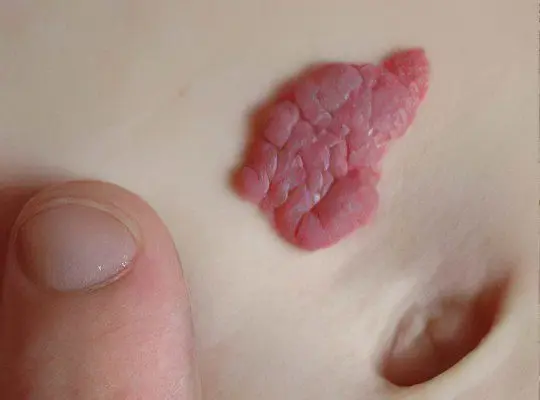What is hemangioma?

Hemangioma is a congenital defect in the development of blood vessels in the dermal layer of the skin. It is considered a pronounced cosmetic defect. Such defects are quite dangerous for the life of the patient. Any injury that damages superficial vessels inevitably leads to bleeding – severe or less pronounced.
The most dangerous situation develops if the cavernous hemangioma is damaged, which has large cavities and is associated with deep-lying vessels. Damaged arterial-type hemangioma can cause gushing bleeding. Also, ulceration can be attributed to a serious complication. The development of phlebitis and thrombophlebitis will become a source of big problems.
In boys, hemangiomas are 2-3 times less common than in girls. Hemangiomas are found immediately after birth, sometimes during the first two months of life.
Hemangiomas are usually localized in the head and neck or in the parotid region.
There are hemangiomas, both single and multiple. With the location of hemangiomas in the perineum and external genital organs, frequent ulceration occurs, as a result, the tumor itself is cured.
Types of hemangioma
Hemangioma can affect different organs and parts of the body. Modern medicine distinguishes several types of hemangiomas.
Hemangioma of the liver – a common neoplasm in the liver, which can only be removed with the help of a surgeon. Hemangioma affects any part of the liver, while its growth is possible. It can go beyond the liver and harm other nearby vital organs, squeezing them.
Kidney hemangioma This benign neoplasm is quite rare.
Spinal hemangioma (vertebral hemangioma) is a very common disease of the spine. It can form both on the mid-thoracic and lower thoracic spine. Rarely there are active tumors with clinical manifestations. Particularly dangerous is the hemangioma of the body of the spine, which causes severe pain, can reduce strength or completely destroy the bone beams of the spine, which serve as a support.
Hemangioma on the lip often found in children on vascular and mucous tissues, is a benign neoplasm.
Symptoms of hemangioma

Simple hemangioma usually has a red or blue-purple color, is located on the surface, the boundaries are clearly defined, affect the skin and a few millimeters of the subcutaneous fat layer, usually grows laterally. Rarely, hemangioma is uneven, slightly protruding above the skin (usually it is smooth). One symptom of a hemangioma is that if you press on it, it turns pale for a short period of time, then returns to its color.
Cavernous hemangioma usually located under the skin, is a limited nodular formation, soft-elastic consistency. It consists of various cavities – caverns filled with blood. Cavernous hemangiomas look like tumor formations, on top the skin is of a normal color, sometimes cyanotic. As the tumor grows, the skin becomes blue-purple in color. When pressing on the hemangioma, it subsides and at the same time turns a little pale (due to the outflow of blood). When crying and coughing hemangioma increases.
Combined hemangioma – usually it is a combination of superficial and subcutaneous hemangiomas (simple and cavernous). It is detected depending on the predominance of one or another part of the vascular tumor. The appearance and consistency, again, depend on the tissues that make up it.
Ways to treat hemangioma
There is no need to treat a hemangioma unless the tumor is growing very large. At the Delta Clinic Medical Center, experts recommend systematically observing a doctor every 3–6 months to control and grow a tumor with an inactive form (less than 12 cm).
Surgical intervention is required in case of rapid growth of hemangioma of the liver. To remove hemangioma, various methods are used – this is liver resection, hemangioma husking, hemangioma sclerosis, cryotherapy, electrocoagulation. In the case of external hemangioma, conservative treatment methods are usually used.










vennumuka noppiki chikithsa theliya jeyandi